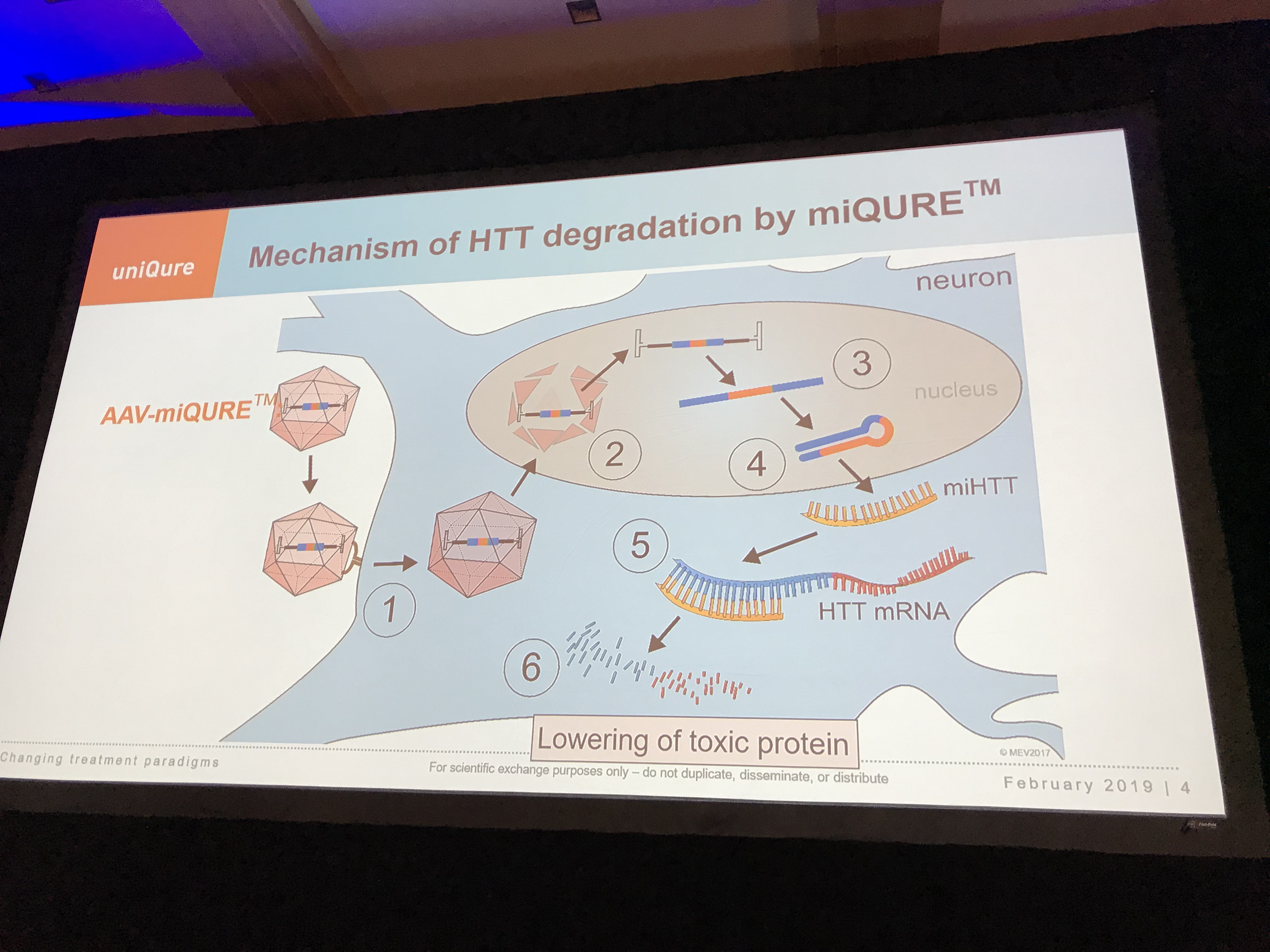
Huntington's disease therapeutics conference 2019 – Day 1
HDBuzz reports from the annual Huntington’s disease therapeutics conference in Palm Springs
Jeff and Ed report from the Huntington’s Disease Therapeutics Conference – the biggest annual gathering of HD researchers. This year’s conference is bigger and more exciting than ever.
Tuesday morning – white matter
Good morning from sunny Palm Springs, and the first day of the 2019 Huntington’s Disease Therapeutics Conference! Up first this morning, a session on “white matter” dysfunction in HD.
The wires that brain cells use to talk to each other are insulated with a fatty white substance called “myelin”, which has a white-ish color. In the brain, myelin is not produced directly by neurons, but by a specialized kind of brain support cell called an “oligodendrocyte”.

Richard Lu is interested in white matter dysfunction in HD, and his early work identified the genes that are important for helping oligodendrocytes form. Lu’s Work has identified drugs that increase cell’s abilities to make white matter, including after damage or injury. Treatment with these drugs has been shown to help animals with nerve damage recover, suggesting they’re capable of helping rebuild white matter. Lu believes these drugs may be useful in HD, where white matter loss is observed, an idea definitely worth testing in animal models of HD.
Peter McColgan is also interested in changes in white matter in HD, which he studies using high tech imaging techniques in humans with the HD mutation. In studies like TRACK-HD, changes in the amount of white matter have been seen in HD even before symptoms begin, but why? And why are some of these connections more vulnerable to damage than others?
We can use the fact that these connections are like tiny little water-filled drainpipes, to studythem using special “diffusion” MRI scans. Water can move along the pipes but not in other directions. The MRI scanner can detect this. If the water moves in unexpected directions, it can indicate that the pipes are damaged. This changes the appearance of them on the scans. Different types of brain cells could be responsible for these altered connections in the HD brain, including the neutrons or the cells who’s job it is to support them by making myelin to insulate their connections. The cortex – the wrinkly outer bit of our brain critical for thinking – is formed in distinct layers, a bit like tree rings. These new scanners are sensitive enough to see and study these layers individually, rather than studying the entire cortex. The layers of the cortex are wired to different parts of the brain, so understanding how the cortex changes, layer-by-layer, is important to understanding the HD brain.
Govinda Poudel is also interested in the breakdown of communication in the brains of HD patients, and uses different types of imaging to map these changes. In particular, connections between the cortex – the wrinkly outer bit of the brain – and a deeper part of the brain called the striatum. These regions are linked together with highways of connections which are insulated with white matter. Poudel’s research has identified specific connections between the cortex and striatum that are particularly vulnerable to breaking down in HD patients. These changes in cortex-striatum connections occur in parallel to HD symptoms, suggesting communication breakdown might directly contribute to symptoms that HD patients care about.
Dorian Pustina, of CHDI, is trying to combine different kinds of MRI scan from the same person, to give the most useful information about how HD affects the brain. The TRACK-HD and TrackOn-HD studies finished years ago, but the scans collected keep giving us new information when imaginative new methods are used to analyse them. Volumetric imaging tells us what is inside the skull. Functional imaging uses blood flow to tell us what the brain is doing. White matter imaging tells us about connections between brain areas. Pustina combined all three, to look at early brain changes in Pre-manifest HD. This work was done with IBM who have computing power to combine and analyse big datasets. He found that adding the baseline white-matter connection data to stuff we already know about patients (age, CAG repeat count), we get extra power to predict how much brain atrophy will probably happen in the subsequent months. However, there’s a note of caution – a lot depends on how the scans are obtained and there is a need to standardise and optimise this in all studies.
Tuesday afternoon – Huntingtin Lowering
This afternoon is a really exciting session focused on “Huntingtin Lowering” – therapies focused on reducing levels of the Huntingtin protein and mRNA.
Up first, Paulina Konstantinova from uniQure who are developing a gene therapy approach to Huntingtin lowering. You can read more background about there recent progress here.
Uniqure’s approach relies on a tiny, harmless, virus called adeno-associated virus (AAV), which carries instructions for a recipe for a gene that helps targeted cells lower Huntingtin levels. The formal name for uniQure’s virus for Huntingtin lowering is “AMT-130”. Because these viruses cant access the brain themselves, they need to be injected using veryfine needles into brain tissue. UniQure plans to start a trial in patients with early manifest HD (similar to the approach used in the other Huntington lowering trials so far). UniQure has tested their virus in cells, and six different animal models of HD. Konstantinova described specific experiments in pig models of HD. It is important to do work in large animals like this, who’s brains are closer in size to our own than mice.
A benefit of viral therapies is that they can be very long lasting, even after a single injection. Konstantinova presented data showing huntingtin lowering in pig brain, one year after a single injection of AMT-130. The virus reduced levels of the Huntingtin protein in important deep brain regions that are vulnerable to damage in HD. In the striatum, the reduction of mutant Huntingtin protein was greater than 70%. Konstantinova showed uniQure’s attempts to identify “bio markers”, or lab tests that can be done to measure the impact huntingtin lowering in the brain. Excitingly, 6 months after a single injection, HD pigs show huntingtin lowering in the spinal fluid between about 25%-70%. This suggests that reductions in Huntingtin in treated animals (and hopefully people) could be monitored without sampling brain tissues. UniQure has discovered that their Huntingtin lowering molecules spread between cells of the brain, which could explain why a single injection of virus leads to such widespread distribution within he brain. Last month, the FDA approved uniQure’s first human trial with AMT-130, which they hope to begin in the first half of 2019.

Up next is Dinah Sah, from Voyager Theraputics, who are also developing a Huntingtin lowering therapy based on AAV delivery of instructions that teaches targeted brain cells how to lower Huntingtin levels. The drug is called VY-HTT01. There are very subtle differences in the payload of the viruses under development by Voyager and uniQure, but both ultimately result in reductions of Huntingtin in targeted cells. Interestingly, Voyager proposes to inject their drug into the thalamus – part of the brain that’s less involved in HD than the striatum, but is heavily connected to other areas, so might be able to spread the virus more widely around. Delivering the virus to the thalamus resulted in its appearance in the cortex, where is lowered Huntingtin in isolated cortical neutrons. It remains to be seen how much Huntington lowering the Voyager approach achieves in an animal model of HD with a big brain.
It is very exciting to see these different approaches to viral delivery of Huntingtin lowering agents – and important to try as many as possible to identify the safest and most efficient one.
Bev Davison has studied Huntingtin lowering therapies for nearly 20 years. Her lab published one of the first demonstrations of Huntingtin lowering in a mouse brain. Recently, Davidson’s lab has been conducting work with genome editing tools, including CRISPR/Cas9, which enable researchers to actually modify DNA. They’re developing tools that allow them to use CRISPR/Cas9 to selectively eliminate the mutant HD gene, and not it’s unmutated or “wild type” partner. We’ve covered this approach on HDBuzz before. Davidson’s lab is not working on new CRISPR/Cas9 tools that don’t need to actually cut DNA to lower Huntingtin levels. If it works, this would presumably be much safer than the traditional method. These new tools not only lower Huntingtin in cells without cutting DNA, but are able to do it in a selective way and reduce only mutant Huntingtin. They’re now working on a new technique which should allow them to turn on the CRISPR/Cas9 tools for brief periods of time. It is much better to only have these scissors floating around cells as long as you need them!
The final presentation today was from Anu Bhattacharya, of PTC Theraputics, who described a totally different approach to Huntingtin lowering.
PTC’s approach relies on “small molecule” drugs that can be taken as a pill, to target specific genes. They’re doing this for multiple genres, including Huntingtin. This is a dramatically different approach from what was presented earlier today. If it works, PTC’s approach would allow Huntingtin lowering across the whole brain with a simple pill. Bhattacharya explained that PTC’s drug works by selectively flagging the Huntingtin messenger for degradation.
In cells, PTC’s drugs very potently reduce Huntingtin levels. When given orally to mice, the same drug reduces brain levels of Huntingtin by up to 80%. More detailed analysis shows that this lowering is very widespread across the brain. PTC is now optimising these drugs to make sure as much as possible gets into the brain and is available to lower Huntingtin. As this process is ongoing, PTC aims to begin human trials as soon as next year.
The day closed with an interesting panel discussion: “How should the HD community prepare to follow up on the results of the HTT-lowering clinical trials, whether positive or negative?”.
With all the diverse Huntingtin lowering therapies in the clinic or approaching it – it is very important to plan for how we’ll understand all the results that are soon to start pouring in.
For more information about our disclosure policy see our FAQ…


